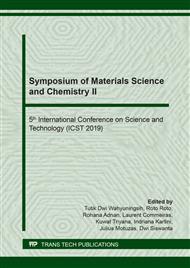p.377
p.385
p.392
p.399
p.406
p.412
p.418
p.424
p.430
Statistical Evaluation of Conventional and Portable Instrumentations for Cr(VI) Analysis on Chemistry Laboratory Waste Water
Abstract:
The development of portable instrumentation for heavy metals analysis was increased rapidly. However, the quality of data from portable methods has so far been questioned when compared to conventional instrumentation. In this research, a comparative study of conventional and portable instrumentations for Cr(VI) analysis on liquid waste water of Chemistry Laboratory at Universitas Gadjah Mada (UGM) was conducted. This research started with validation and statistical evaluation of instrumentation methods which are UV-Visible spectrophotometer, portable spectrophotometer (PiCOEXPLORER) and Inductively Coupled Plasma Atomic Emission Spectrometer (ICP-AES). The validation methods consist of determination of linearity, sensitivity, limit of detection and limit of quantification. The results showed that the validation methods of ICP-AES were better than PiCOEXPLORER and UV-Vis spectrophotometer. Based on t-test, it was obtained that the result of Cr(VI) analyses with the comparison of UV-Vis and PiCOEXPLORER, ICP-AES and PiCOEXPLORER, and UV-Vis and ICP-AES; there were no significant difference (tcount< ttable). The ANOVA test (F test) results showed that the Fcount value is less than Ftable so that the results of Cr(VI) analysis in the standard solution and liquid waste samples measured by three instrumentations. Thus, it was concluded that portable instrumentations was good and gives the same quality as conventional instrumentations (UV-Vis and ICP AES).
Info:
Periodical:
Pages:
406-411
Citation:
Online since:
April 2020
Authors:
Keywords:
Price:
Сopyright:
© 2020 Trans Tech Publications Ltd. All Rights Reserved
Share:
Citation:


